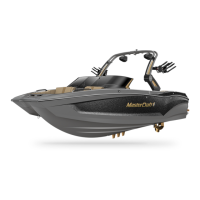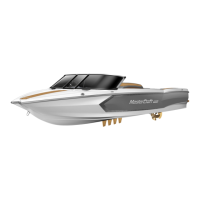2005 MASTERCRAFT OWNERS MANUAL–PAG E 16-3
Battery electrolyte fluid is dangerous. It contains sulfuric acid, which is poisonous, corrosive
and caustic. If electrolyte is spilled or placed on any part of the human body, immediately
flush the area with large amounts of clean water and seek medical aid.
• Use a battery terminal cleaning brush to remove corrosion from the inside of the battery terminals. Clean the terminals with a
water-and-baking-soda solution and rinse.
• Reconnect the positive terminal first, then the negative. Tighten the terminals. Coat both terminals completely with a thin
covering of marine grease. Be sure that the rubber boot covers the positive terminal completely.
Note: Your engine is designed to work with the standard electronics installed in your boat. If you add other electrical
components or acccessories, you could change the way the fuel injection controls your engine or the overall electrical system
functions. Before adding electrical equipment, consult your dealer. If you don’t, your engine may not perform properly.
Add-on equipment may adversely affect the alternator output or overload the electrical
system. Any damage caused as a result will not be covered by, and may void, your warranty.
If you ever need a replacement battery, be certain to select a marine battery with at least 750 cold-cranking amps at zero
degrees Fahrenheit. Before disconnecting the battery, make sure the ignition key and all accessories are in the OFF position. Also
remember to re-attach the cables correctly, with the negative cable connected to the negative or (-) post and the positive cable
connected to the positive or (+) post.
When charging, batteries generate small amounts of dangerous hydrogen gas. This gas is
highly explosive. Keep all sparks, flames and smoking well away from the area. Failure to
follow instructions when charging a battery can cause an electrical charge or even an explosion
of the battery which could cause serious injury or death
MasterCraft recommends the use of a spiral cell type battery, such as the Optima brand. These batteries exceed most other
batteries in holding and extending a charge.
INSPECT THE ENGINE
FOR LOOSE OR MISSING HARDWARE
Because this process should be completed while the en-
gine is cool and cannot cause burns to your skin, we recom-
mend you do this before starting your boat.
Step 1: Ensure the engine is OFF and the engine safety start-
ing switch disconnected. Be certain that the throttle/shift con-
trol lever is in neutral. Open the engine compartment and vi-
sually inspect the engine.
Step 2: Systematically check the entire engine for loose
and missing hardware. Try to shake components by hand
such as the alternator and the motor mounts. If a loose-
ness problem exists, see your MasterCraft dealer.

